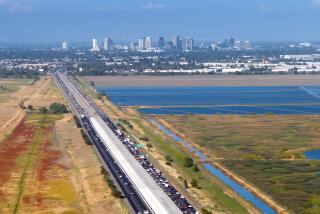Conferees Back $151-Billion Transport Bill
- Share via
WASHINGTON — After two weeks of bruising talks, House and Senate negotiators unveiled a six-year, $151-billion transportation bill Tuesday that would double spending on mass transit and give states unprecedented flexibility to switch funds from roads to bus and rail programs.
Despite the accord on the massive public works package, which would overhaul the way the federal government parcels out transportation aid, some members of Congress threatened to oppose the bill because their states did not receive a larger share of federal money.
Nevertheless, congressional leaders of both parties predicted that the legislation would win passage when it came to the House and Senate for final consideration early today.
“It has been a grueling, grueling effort,” said Rep. Robert A. Roe (D-N. J.), chairman of the 92-member conference committee that completed work on the legislation Tuesday afternoon.
In Orange County, the bill would provide about $15 million to build special ramps to connect downtown Anaheim directly to car-pool lanes on the Santa Ana Freeway and about $4 million to widen Bristol Street in Santa Ana.
In addition, it would authorize spending about $9 million to study ways to improve the capacity of the Santa Ana Freeway between downtown Los Angeles and Buena Park. It also would set aside an as yet undetermined amount for grade-separation projects along the Los Angeles-San Diego rail corridor.
The legislation also includes tightly drawn language that would ease legal barriers to the construction of the three multibillion-dollar toll roads to be built through Orange County.
The bill calls for overall spending of $119.5 billion in highway funds and $31.5 billion in transit money over the six-year period. To help pay for the program, the legislation would extend for three years--until 1999--2.5 cents of a 5-cent-a-gallon increase in the federal gasoline tax that was enacted a year ago. The tax now stands at 14 cents a gallon, but last year’s increase was scheduled to expire in 1996.
House leaders originally proposed raising the gas tax by another nickel, to 19 cents, to finance highway improvement, but abandoned the idea after it ran into widespread opposition last summer.
California would receive more than $10.5 billion in highway funds over the six years. The legislation would set aside at least $1.4 billion in transit money for the state, most of which would pay for extensions of the Los Angeles Metro Rail and Bay Area Rapid Transit systems.
The bill earmarks more than $5.4 billion for controversial “demonstration projects” in members’ home states and districts. The projects have been widely criticized as examples of “pork-barrel” politics.
Despite the inclusion of the projects, Transportation Secretary Samuel K. Skinner said Tuesday he would recommend that President Bush sign the transportation package. Even though he had earlier voiced concerns about the projects, Skinner called the bill “a victory for the nation, its citizens and the President.”
In addition to rebuilding crumbling roads and bridges, Skinner said that the bill would create jobs and give a positive jolt to the economy, a theme that was embraced by congressional leaders as they sought support for the measure earlier this fall.
The transportation measure would radically alter the structure of federal aid programs that have been in place since 1956, when Congress decided to finance construction of the 43,000-mile system of interstate highways, which is now all but complete.
“This is the first transportation legislation of the post-interstate era,” said Sen. Daniel Patrick Moynihan (D-N. Y.), vice chairman of the conference committee and one of the principal authors of the bill. “We have poured enough concrete. Our primary objective (now) must be to improve . . . the system we have.”
Instead of specifically earmarking federal aid for interstate resurfacing or rural roads, the new legislation would create two major pots of highway money from which states could draw. States would be free to spend much of that money on bus or rail systems, as well as on highways.
A $24-billion surface transportation program would finance either road building or mass transit projects, at each state’s discretion. The bill also would create a $38-billion pool to pay for work on a 150,000-mile National Highway System, which would include the existing interstate network. Up to 50% of those funds could be spent on transit instead of roads.
The bill would give local planning agencies wide leeway to determine how federal transportation money would be spent in their areas. Nearly two-thirds of the funds in the surface transportation program would be handed out by states to urban planning agencies in areas with populations of 200,000 or more.
In Orange County, the bill would exempt the planned toll roads from some, but not all, provisions of laws that ban the use of federal funds to build highways through or near public parklands. The exemption applies only to parklands that are acquired by public agencies as part of highway construction projects--that is, to private property that would not have become parkland if the highways had not been built.
The legislation also would include a $6-billion program for congestion relief, a $16-billion bridge repair program, and smaller programs to promote so-called smart highways and magnetically levitated, high-speed trains.
To the chagrin of House leaders, however, the legislation would largely keep in place the formulas, some dating back more than 70 years, that the federal government uses to parcel out highway aid to the states. House members had proposed using new factors, such as fuel consumption and miles traveled, that would direct more federal aid to rapidly growing states.
It was the fight over the formulas that produced the most animosity and delayed an agreement on the legislation until literally the eleventh hour.
The outcome of that battle deeply disappointed representatives from the so-called donor states, including California and Florida, whose citizens generally contribute more in federal highway taxes than the states get back in transportation aid.
Congressmen from the 15 or so historic donor states argued that they should no longer be required to substantially subsidize road building and repair in sparsely populated Western states with long stretches of highway, a system that was established to finance construction of the interstates.
Sen. Bob Graham (D-Fla.) had threatened a filibuster over the issue. A Graham spokesman said that the senator “feels there are inequities in the bill that do not represent good transportation policy or good public policy. The growth states are not dealt with fairly.”
But Rep. Ron Packard (R-Oceanside), a member of the conference committee, was more sanguine.
“I’m disappointed in the fact that we weren’t able to make structural changes in the formula that would benefit or at least balance out the inequities that we’ve lived with in the donor states,” Packard said. “But dollar-wise and in many other areas, California came out quite well.”
Not only would California get more highway aid than any other state, it would receive $1.3 billion for expansion of two major mass transit systems. The bill would provide $568.5 million to extend BART south from San Francisco. And it would set aside $695 million to build three new sections of the Metro Rail system in Los Angeles.
The bill also contains safety provisions that would encourage states to enact motorcycle helmet and seat-belt laws and ban certain double- and triple-trailer truck rigs from states that do not now permit them.
More to Read
Sign up for Essential California
The most important California stories and recommendations in your inbox every morning.
You may occasionally receive promotional content from the Los Angeles Times.










